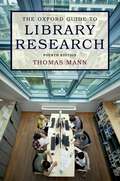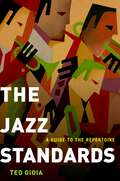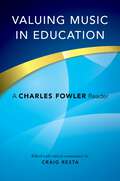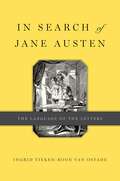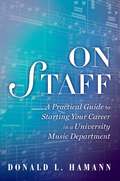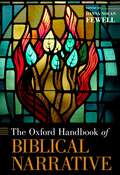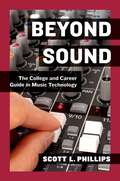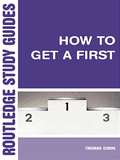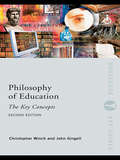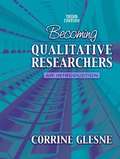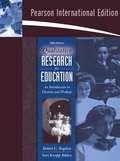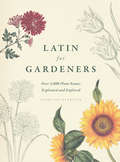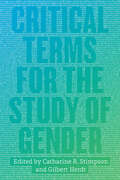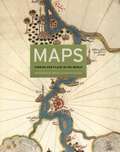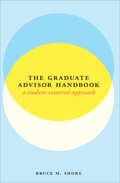- Table View
- List View
The Oxford Guide to Library Research
by Thomas MannThe information world has undergone drastic changes since the publication of the 3rd edition of The Oxford Guide to Library Research in 2005, and Thomas Mann, a veteran reference librarian at the Library of Congress, has extensively revised his text to reflect those changes. This book will answer two basic questions: First, what is the extent of the significant research resources you will you miss if you confine your research entirely, or even primarily, to sources available on the open Internet? Second, if you are trying to get a reasonably good overview of the literature on a particular topic, rather than just "something quickly" on it, what are the several alternative methods of subject searching--which are not available on the Web--that are usually much more efficient for that purpose than typing keywords into a blank search box, with the results displayed by relevance-ranking computer algorithms? This book shows researchers how to do comprehensive research on any topic. It explains the variety of search mechanisms available, so that the researcher can have the reasonable confidence that s/he has not overlooked something important. This includes not just lists of resources, but discussions of the ways to search within them: how to find the best search terms, how to combine the terms, and how to make the databases (and other sources) show relevant material even when you don't know how to specify the best search terms in advance. The book's overall structuring by nine methods of searching that are applicable in any subject area, rather than by subjects or by types of literature, is unique among guides to research. Also unique is the range and variety of concrete examples of what to do--and of what not to do. The book is not "about" the Internet: it is about the best alternatives to the Internet--the sources that are not on the open Web to begin with, that can be found only through research libraries and that are more than ever necessary for any kind of substantive scholarly research. More than any other research guide available, this book directly addresses and provides solutions to the serious problems outlined in recent studies documenting the profound lack of research skills possessed by today's "digital natives."
The Jazz Standards: A Guide to the Repertoire
by Ted GioiaThe Jazz Standards, a comprehensive guide to the most important jazz compositions, is a unique resource, a browser's companion, and an invaluable introduction to the art form. This essential book for music lovers tells the story of more than 250 key jazz songs, and includes a listening guide to more than 2,000 recordings. Many books recommend jazz CDs or discuss musicians and styles, but this is the first to tell the story of the songs themselves. The fan who wants to know more about a jazz song heard at the club or on the radio will find this book indispensable. Musicians who play these songs night after night now have a handy guide, outlining their history and significance and telling how they have been performed by different generations of jazz artists. Students learning about jazz standards now have a complete reference work for all of these cornerstones of the repertoire. Author Ted Gioia, whose body of work includes the award-winning The History of Jazz and Delta Blues, is the perfect guide to lead readers through the classics of the genre. As a jazz pianist and recording artist, he has performed these songs for decades. As a music historian and critic, he has gained a reputation as a leading expert on jazz. Here he draws on his deep experience with this music in creating the ultimate work on the subject. An introduction for new fans, a useful handbook for jazz enthusiasts and performers, and an important reference for students and educators, The Jazz Standards belongs on the shelf of every serious jazz lover or musician.
Valuing Music in Education: A Charles Fowler Reader
Noted music education and arts activist Charles Fowler has inspired music educators for more than 60 years. In this book, editor Craig Resta brings together the most important of Fowler's writings from the journal Musical America for new generations of readers. Here, Fowler speaks to many timeless issues including creativity and culture in the classroom, school funding, reform and policy, assessment and pedagogy, and equality and pluralism in music education. The articles are both research-based and practical, and helpful for many of the most important concerns in school-based advocacy and scholarly inquiry today. Resta offers critical commentary with compelling background to these enduring pieces, placing them in a context that clarifies the benefit of their message to music and arts education. Fowler's words speak to all who have a stake in music education: students, teachers, parents, administrators, performers, community members, business leaders, arts advocates, scholars, professors, and researchers alike. Valuing Music in Education is ideal for everyone who understands the critical role of music in schools and society.
On Staff: A Practical Guide to Starting Your Career in a University Music Department
by Dr. Donald L. HamannA practical guide to starting a successful career in a music department in higher education, this book thoroughly details the application, interview, and negotiation processes. It offers a wealth of practical information on getting a post, your first days in the post, acquiring tenure and promotion, working with colleagues and administration, beginning your career, and learning about yourself in the higher education setting. This book will show you how to: --Organize your professional experiences in an eye-appealing and easily read CV --Develop attention catching cover letters that avoid common pitfalls and instead create positive, lasting impressions --Create meaningful teaching philosophies and research statements --Acquire effective interview techniques by becoming aware of frequently asked interview questions, the nuances of interview apparel, dining etiquette, and recognizing what committees and administrators are looking for in a candidate --Negotiate job offers effectively And once you get that position, this book will show you how to keep it, to get tenure and promotion, and to be successful in your chosen higher education institution. Visit the comprehensive companion website at www.oup.com/us/onstaff
The Oxford Handbook of Biblical Narrative (Oxford Handbooks)
Comprised of contributions from scholars across the globe, The Oxford Handbook of Biblical Narrative is a state-of-the-art anthology, offering critical treatments of both the Bible's narratives and topics related to the Bible's narrative constructions. The Handbook covers the Bible's narrative literature, from Genesis to Revelation, providing concise overviews of literary-critical scholarship as well as innovative readings of individual narratives informed by a variety of methodological approaches and theoretical frameworks. The volume as a whole combines literary sensitivities with the traditional historical and sociological questions of biblical criticism and puts biblical studies into intentional conversation with other disciplines in the humanities. It reframes biblical literature in a way that highlights its aesthetic characteristics, its ethical and religious appeal, its organic qualities as communal literature, its witness to various forms of social and political negotiation, and its uncanny power to affect readers and hearers across disparate time-frames and global communities.
Beyond Sound: The College and Career Guide in Music Technology
by Scott L. PhillipsBeyond Sound is a must-read for anyone who loves music technology and wants to build a career in this competitive, fast-paced world. Author Scott L. Phillips draws on his seventeen-year career as a technology trainer and educator, and his extensive network of music technology professionals, to present an intimate view of the exciting world of music technology. The book offers an in-depth consideration of music technology education, including looks at specific programs and a clear explanation of different types of degrees. Moreover, it provides practical guidance on career preparation, including how to get a great internship, how to land that first job, and how to make connections and move up in a variety of businesses from recording to television and film to video games. And Phillips brings stories from successful professionals, who share their experiences, advice, and suggestions.
Beyond Sound: The College and Career Guide in Music Technology
by Scott L. PhillipsBeyond Sound is a must-read for anyone who loves music technology and wants to build a career in this competitive, fast-paced world. Author Scott L. Phillips draws on his seventeen-year career as a technology trainer and educator, and his extensive network of music technology professionals, to present an intimate view of the exciting world of music technology. The book offers an in-depth consideration of music technology education, including looks at specific programs and a clear explanation of different types of degrees. Moreover, it provides practical guidance on career preparation, including how to get a great internship, how to land that first job, and how to make connections and move up in a variety of businesses from recording to television and film to video games. And Phillips brings stories from successful professionals, who share their experiences, advice, and suggestions.
On Staff: A Practical Guide to Starting Your Career in a University Music Department
by Dr. Donald L. HamannA practical guide to starting a successful career in a music department in higher education, this book thoroughly details the application, interview, and negotiation processes. It offers a wealth of practical information on getting a post, your first days in the post, acquiring tenure and promotion, working with colleagues and administration, beginning your career, and learning about yourself in the higher education setting. This book will show you how to: --Organize your professional experiences in an eye-appealing and easily read CV --Develop attention catching cover letters that avoid common pitfalls and instead create positive, lasting impressions --Create meaningful teaching philosophies and research statements --Acquire effective interview techniques by becoming aware of frequently asked interview questions, the nuances of interview apparel, dining etiquette, and recognizing what committees and administrators are looking for in a candidate --Negotiate job offers effectively And once you get that position, this book will show you how to keep it, to get tenure and promotion, and to be successful in your chosen higher education institution. Visit the comprehensive companion website at www.oup.com/us/onstaff
How To Get A First: The Essential Guide To Academic Success (PDF)
by Thomas DixonIn this informative guide, Thomas Dixon argues that you do not have to be a genius to get a first at university. He sets out to de-mystify first-class degrees in the arts, humanities and social sciences, clearly articulating the difference between the excellent and the merely competent in undergraduate work. This concise, no-nonsense guidebook will give prospective and current students advice on teaching and learning styles that prevail in university and on how to manage their two most important resources - their time and their lecturers. In an accessible and entertaining style, the author looks at subjects such as: making the transition from school to university developing transferable skills making use of lectures and seminars using libraries and the Internet note-taking, essays, seminars and presentations common mistakes to avoid writing with clarity and style revision and examinations. Illustrated with many examples from a range of academic disciplines, How to Get a First is an all-purpose guide to success in academic life. Visit the companion website www. getafirst. com
Philosophy Of Education: The Key Concepts (Routledge Key Guides)
by John Gingell Christopher WinchThis new edition of Philosophy of Education: The Key Concepts is an easy to use A-Z guide summarizing all the key terms, ideas and issues central to the study of educational theory today. Fully updated, the book is cross-referenced throughout and contains pointers to further reading, as well as new entries on such topics as: Citizenship and Civic Education Liberalism Capability Well-being Patriotism Globalisation Open-mindedness Creationism and Intelligent Design. Comprehensive and authoritative this highly accessible guide provides all that a student, teacher or policy-maker needs to know about the latest thinking on education in the 21st century.'
Becoming Qualitative Researchers: An Introduction (PDF)
by Corrine GlesneThis text offers a brief but comprehensive overview of qualitative research that balances the practicalities of conducting research and the theory and debates that keep qualitative inquiry vibrant. As faculty and students increasingly turn to qualitative inquiry, they need a text that will not only provide them with an understanding of qualitative research methods, but also open them to the diverse possibilities within this inquiry approach. This text covers the range of possibilities along with numerous exercises that offer beginning students the opportunity to practice and refine the skills of being a qualitative researcher. The wealth of examples in the text is exceptional, as is the accessible writing style. This edition: situates ethnographic/ qualitative research in context and traces its history, illustrating some of the tensions in qualitative research approaches and practices in the past and present; . . .
Qualitative Research For Education: An Introduction To Theories And Methods (PDF)
by Robert Bogdan Sari BiklenThis concise, applied, and very clearly written introduction to qualitative research methods can be used effectively in any semester, or year-long course. The purpose of this introductory-level text is to provide the reader with a background for understanding the uses of qualitative research in education (and other professions), to examine its theoretical and historical underpinnings, and to provide the how-to's of doing qualitative research. This new edition places qualitative research within current debates about research methods and alternative ways of knowing. While the authors approach the subject from a sociological perspective, they also take care to reflect the many changes in conceptualization of qualitative research brought by post-structural and feminist thought.
Latin for Gardeners: Over 3,000 Plant Names Explained and Explored
by Lorraine HarrisonSince Latin became the standard language for plant naming in the eighteenth century, it has been intrinsically linked with botany. And while mastery of the classical language may not be a prerequisite for tending perennials, all gardeners stand to benefit from learning a bit of Latin and its conventions in the field. Without it, they might buy a Hellebores foetidus and be unprepared for its fetid smell, or a Potentilla reptans with the expectation that it will stand straight as a sentinel rather than creep along the ground. An essential addition to the gardener’s library, this colorful, fully illustrated book details the history of naming plants, provides an overview of Latin naming conventions, and offers guidelines for pronunciation. Readers will learn to identify Latin terms that indicate the provenance of a given plant and provide clues to its color, shape, fragrance, taste, behavior, functions, and more. Full of expert instruction and practical guidance, Latin for Gardeners will allow novices and green thumbs alike to better appreciate the seemingly esoteric names behind the plants they work with, and to expertly converse with fellow enthusiasts. Soon they will realize that having a basic understanding of Latin before trips to the nursery or botanic garden is like possessing some knowledge of French before traveling to Paris; it enriches the whole experience.
Critical Terms for the Study of Gender (Critical Terms)
by Catharine R. Stimpson and Gilbert Herdt“Gender systems pervade and regulate human lives—in law courts and operating rooms, ballparks and poker clubs, hair-dressing salons and kitchens, classrooms and playgroups. . . . Exactly how gender works varies from culture to culture, and from historical period to historical period, but gender is very rarely not at work. Nor does gender operate in isolation. It is linked to other social structures and sources of identity.” So write women’s studies pioneer Catharine R. Stimpson and anthropologist Gilbert Herdt in their introduction to Critical Terms for the Study of Gender, laying out the wide-ranging nature of this interdisciplinary and rapidly changing field. The sixth in the series of “Critical Terms” books, this volume provides an indispensable introduction to the study of gender through an exploration of key terms that are a part of everyday discourse in this vital subject. Following Stimpson and Herdt’s careful account of the evolution of gender studies and its relation to women’s and sexuality studies, the twenty-one essays here cast an appropriately broad net, spanning the study of gender and sexuality across the humanities and social sciences. Written by a distinguished group of scholars, each essay presents students with a history of a given term—from bodies to utopia—and explains the conceptual baggage it carries and the kinds of critical work it can be made to do. The contributors offer incisive discussions of topics ranging from desire, identity, justice, and kinship to love, race, and religion that suggest new directions for the understanding of gender studies. The result is an essential reference addressed to students studying gender in very different disciplinary contexts.
Critical Terms for the Study of Gender (Critical Terms)
by Catharine R. Stimpson Gilbert Herdt“Gender systems pervade and regulate human lives—in law courts and operating rooms, ballparks and poker clubs, hair-dressing salons and kitchens, classrooms and playgroups. . . . Exactly how gender works varies from culture to culture, and from historical period to historical period, but gender is very rarely not at work. Nor does gender operate in isolation. It is linked to other social structures and sources of identity.” So write women’s studies pioneer Catharine R. Stimpson and anthropologist Gilbert Herdt in their introduction to Critical Terms for the Study of Gender, laying out the wide-ranging nature of this interdisciplinary and rapidly changing field. The sixth in the series of “Critical Terms” books, this volume provides an indispensable introduction to the study of gender through an exploration of key terms that are a part of everyday discourse in this vital subject. Following Stimpson and Herdt’s careful account of the evolution of gender studies and its relation to women’s and sexuality studies, the twenty-one essays here cast an appropriately broad net, spanning the study of gender and sexuality across the humanities and social sciences. Written by a distinguished group of scholars, each essay presents students with a history of a given term—from bodies to utopia—and explains the conceptual baggage it carries and the kinds of critical work it can be made to do. The contributors offer incisive discussions of topics ranging from desire, identity, justice, and kinship to love, race, and religion that suggest new directions for the understanding of gender studies. The result is an essential reference addressed to students studying gender in very different disciplinary contexts.
Critical Terms for the Study of Gender (Critical Terms)
“Gender systems pervade and regulate human lives—in law courts and operating rooms, ballparks and poker clubs, hair-dressing salons and kitchens, classrooms and playgroups. . . . Exactly how gender works varies from culture to culture, and from historical period to historical period, but gender is very rarely not at work. Nor does gender operate in isolation. It is linked to other social structures and sources of identity.” So write women’s studies pioneer Catharine R. Stimpson and anthropologist Gilbert Herdt in their introduction to Critical Terms for the Study of Gender, laying out the wide-ranging nature of this interdisciplinary and rapidly changing field. The sixth in the series of “Critical Terms” books, this volume provides an indispensable introduction to the study of gender through an exploration of key terms that are a part of everyday discourse in this vital subject. Following Stimpson and Herdt’s careful account of the evolution of gender studies and its relation to women’s and sexuality studies, the twenty-one essays here cast an appropriately broad net, spanning the study of gender and sexuality across the humanities and social sciences. Written by a distinguished group of scholars, each essay presents students with a history of a given term—from bodies to utopia—and explains the conceptual baggage it carries and the kinds of critical work it can be made to do. The contributors offer incisive discussions of topics ranging from desire, identity, justice, and kinship to love, race, and religion that suggest new directions for the understanding of gender studies. The result is an essential reference addressed to students studying gender in very different disciplinary contexts.
Critical Terms for the Study of Gender (Critical Terms)
by Catharine R. Stimpson Gilbert Herdt“Gender systems pervade and regulate human lives—in law courts and operating rooms, ballparks and poker clubs, hair-dressing salons and kitchens, classrooms and playgroups. . . . Exactly how gender works varies from culture to culture, and from historical period to historical period, but gender is very rarely not at work. Nor does gender operate in isolation. It is linked to other social structures and sources of identity.” So write women’s studies pioneer Catharine R. Stimpson and anthropologist Gilbert Herdt in their introduction to Critical Terms for the Study of Gender, laying out the wide-ranging nature of this interdisciplinary and rapidly changing field. The sixth in the series of “Critical Terms” books, this volume provides an indispensable introduction to the study of gender through an exploration of key terms that are a part of everyday discourse in this vital subject. Following Stimpson and Herdt’s careful account of the evolution of gender studies and its relation to women’s and sexuality studies, the twenty-one essays here cast an appropriately broad net, spanning the study of gender and sexuality across the humanities and social sciences. Written by a distinguished group of scholars, each essay presents students with a history of a given term—from bodies to utopia—and explains the conceptual baggage it carries and the kinds of critical work it can be made to do. The contributors offer incisive discussions of topics ranging from desire, identity, justice, and kinship to love, race, and religion that suggest new directions for the understanding of gender studies. The result is an essential reference addressed to students studying gender in very different disciplinary contexts.
Critical Terms for the Study of Gender (Critical Terms)
by Catharine R. Stimpson and Gilbert Herdt“Gender systems pervade and regulate human lives—in law courts and operating rooms, ballparks and poker clubs, hair-dressing salons and kitchens, classrooms and playgroups. . . . Exactly how gender works varies from culture to culture, and from historical period to historical period, but gender is very rarely not at work. Nor does gender operate in isolation. It is linked to other social structures and sources of identity.” So write women’s studies pioneer Catharine R. Stimpson and anthropologist Gilbert Herdt in their introduction to Critical Terms for the Study of Gender, laying out the wide-ranging nature of this interdisciplinary and rapidly changing field. The sixth in the series of “Critical Terms” books, this volume provides an indispensable introduction to the study of gender through an exploration of key terms that are a part of everyday discourse in this vital subject. Following Stimpson and Herdt’s careful account of the evolution of gender studies and its relation to women’s and sexuality studies, the twenty-one essays here cast an appropriately broad net, spanning the study of gender and sexuality across the humanities and social sciences. Written by a distinguished group of scholars, each essay presents students with a history of a given term—from bodies to utopia—and explains the conceptual baggage it carries and the kinds of critical work it can be made to do. The contributors offer incisive discussions of topics ranging from desire, identity, justice, and kinship to love, race, and religion that suggest new directions for the understanding of gender studies. The result is an essential reference addressed to students studying gender in very different disciplinary contexts.
Critical Terms for the Study of Gender (Critical Terms)
by Catharine R. Stimpson and Gilbert Herdt“Gender systems pervade and regulate human lives—in law courts and operating rooms, ballparks and poker clubs, hair-dressing salons and kitchens, classrooms and playgroups. . . . Exactly how gender works varies from culture to culture, and from historical period to historical period, but gender is very rarely not at work. Nor does gender operate in isolation. It is linked to other social structures and sources of identity.” So write women’s studies pioneer Catharine R. Stimpson and anthropologist Gilbert Herdt in their introduction to Critical Terms for the Study of Gender, laying out the wide-ranging nature of this interdisciplinary and rapidly changing field. The sixth in the series of “Critical Terms” books, this volume provides an indispensable introduction to the study of gender through an exploration of key terms that are a part of everyday discourse in this vital subject. Following Stimpson and Herdt’s careful account of the evolution of gender studies and its relation to women’s and sexuality studies, the twenty-one essays here cast an appropriately broad net, spanning the study of gender and sexuality across the humanities and social sciences. Written by a distinguished group of scholars, each essay presents students with a history of a given term—from bodies to utopia—and explains the conceptual baggage it carries and the kinds of critical work it can be made to do. The contributors offer incisive discussions of topics ranging from desire, identity, justice, and kinship to love, race, and religion that suggest new directions for the understanding of gender studies. The result is an essential reference addressed to students studying gender in very different disciplinary contexts.
Maps: Finding Our Place in the World (Kenneth Nebenzahl, Jr., Lectures In The History Of Cartography)
by James R. Akerman Robert W. Karrow John McCarterMaps are universal forms of communication, easily understood and appreciated regardless of culture or language. This truly magisterial book introduces readers to the widest range of maps ever considered in one volume: maps from different time periods and a variety of cultures; maps made for divergent purposes and depicting a range of environments; and maps that embody the famous, the important, the beautiful, the groundbreaking, or the amusing. Built around the functions of maps—the kinds of things maps do and have done—Maps confirms the vital role of maps throughout history in commerce, art, literature, and national identity. The book begins by examining the use of maps for wayfinding, revealing that even maps as common and widely used as these are the product of historical circumstances and cultural differences. The second chapter considers maps whose makers employed the smallest of scales to envision the broadest of human stages—the world, the heavens, even the act of creation itself. The next chapter looks at maps that are, literally, at the opposite end of the scale from cosmological and world maps—maps that represent specific parts of the world and provide a close-up view of areas in which their makers lived, worked, and moved. Having shown how maps help us get around and make sense of our greater and lesser worlds, Maps then turns to the ways in which certain maps can be linked to particular events in history, exploring how they have helped Americans, for instance, to understand their past, cope with current events, and plan their national future. The fifth chapter considers maps that represent data from scientific instruments, population censuses, and historical records. These maps illustrate, for example, how diseases spread, what the ocean floor looks like, and how the weather is tracked and predicted. Next comes a turn to the imaginary, featuring maps that depict entire fictional worlds, from Hell to Utopia and from Middle Earth to the fantasy game World of Warcraft. The final chapter traces the origins of map consumption throughout history and ponders the impact of cartography on modern society. A companion volume to the most ambitious exhibition on the history of maps ever mounted in North America, Maps will challenge readers to stretch conventional thought about what constitutes a map and how many different ways we can understand graphically the environment in which we live. Collectors, historians, mapmakers and users, and anyone who has ever “gotten lost” in the lines and symbols of a map will find much to love and learn from in this book.
The Graduate Advisor Handbook: A Student-Centered Approach (Chicago Guides to Academic Life)
by Bruce M. ShoreIn the sink-or-swim world of academia, a great graduate advising can be a lifesaver. But with university budgets shrinking and free time evaporating, advisors often need a mentor themselves to learn how to best support their advisees. Bruce M. Shore, an award-winning advisor with more than forty years of advising experience, is just the coach that graduate advisors need. With The Graduate Advisor Handbook: A Student-Centered Approach, Shore demystifies the advisor-student relationship, providing tips and practical advice that will help both students and advisors thrive. One of the first books to approach advising from the advisor’s point of view, the handbook highlights the importance of a partnership in which both parties need to be invested. Shore emphasizes the interpersonal relationships at the heart of advising and reveals how advisors can draw on their own strengths to create a rewarding rapport. The Graduate Advisor Handbook moves chronologically through the advising process, from the first knock on the door to the last reference letter. Along the way it covers transparent communication, effective motivation, and cooperative troubleshooting. Its clear-eyed approach also tackles touchy subjects, including what to do when personal boundaries are crossed and how to deliver difficult news. Sample scripts help advisors find the right words for even the toughest situations. With resources dwindling and student and advising loads increasing, graduate advisors need all the resources they can find to give their students the help they need. The Graduate Advisor Handbook has the cool-headed advice and comprehensive coverage that advisors need to make the advising relationship not just effective but also enjoyable.
The Graduate Advisor Handbook: A Student-Centered Approach (Chicago Guides to Academic Life)
by Bruce M. ShoreIn the sink-or-swim world of academia, a great graduate advising can be a lifesaver. But with university budgets shrinking and free time evaporating, advisors often need a mentor themselves to learn how to best support their advisees. Bruce M. Shore, an award-winning advisor with more than forty years of advising experience, is just the coach that graduate advisors need. With The Graduate Advisor Handbook: A Student-Centered Approach, Shore demystifies the advisor-student relationship, providing tips and practical advice that will help both students and advisors thrive. One of the first books to approach advising from the advisor’s point of view, the handbook highlights the importance of a partnership in which both parties need to be invested. Shore emphasizes the interpersonal relationships at the heart of advising and reveals how advisors can draw on their own strengths to create a rewarding rapport. The Graduate Advisor Handbook moves chronologically through the advising process, from the first knock on the door to the last reference letter. Along the way it covers transparent communication, effective motivation, and cooperative troubleshooting. Its clear-eyed approach also tackles touchy subjects, including what to do when personal boundaries are crossed and how to deliver difficult news. Sample scripts help advisors find the right words for even the toughest situations. With resources dwindling and student and advising loads increasing, graduate advisors need all the resources they can find to give their students the help they need. The Graduate Advisor Handbook has the cool-headed advice and comprehensive coverage that advisors need to make the advising relationship not just effective but also enjoyable.
The Graduate Advisor Handbook: A Student-Centered Approach (Chicago Guides to Academic Life)
by Bruce M. ShoreIn the sink-or-swim world of academia, a great graduate advising can be a lifesaver. But with university budgets shrinking and free time evaporating, advisors often need a mentor themselves to learn how to best support their advisees. Bruce M. Shore, an award-winning advisor with more than forty years of advising experience, is just the coach that graduate advisors need. With The Graduate Advisor Handbook: A Student-Centered Approach, Shore demystifies the advisor-student relationship, providing tips and practical advice that will help both students and advisors thrive. One of the first books to approach advising from the advisor’s point of view, the handbook highlights the importance of a partnership in which both parties need to be invested. Shore emphasizes the interpersonal relationships at the heart of advising and reveals how advisors can draw on their own strengths to create a rewarding rapport. The Graduate Advisor Handbook moves chronologically through the advising process, from the first knock on the door to the last reference letter. Along the way it covers transparent communication, effective motivation, and cooperative troubleshooting. Its clear-eyed approach also tackles touchy subjects, including what to do when personal boundaries are crossed and how to deliver difficult news. Sample scripts help advisors find the right words for even the toughest situations. With resources dwindling and student and advising loads increasing, graduate advisors need all the resources they can find to give their students the help they need. The Graduate Advisor Handbook has the cool-headed advice and comprehensive coverage that advisors need to make the advising relationship not just effective but also enjoyable.
